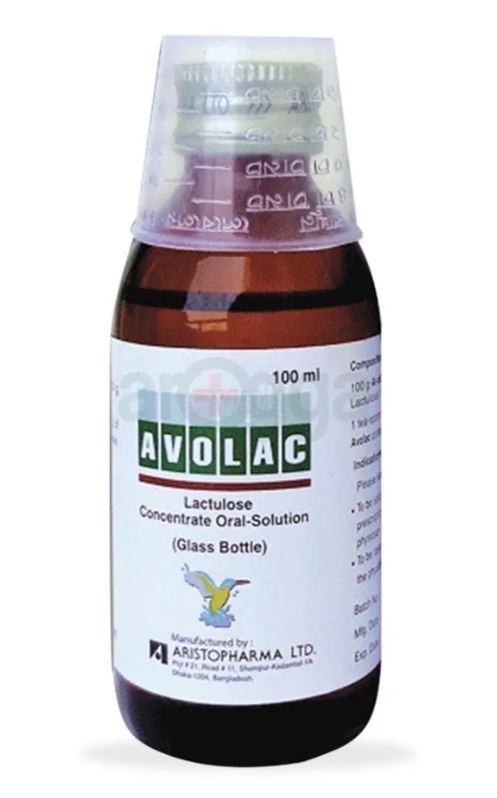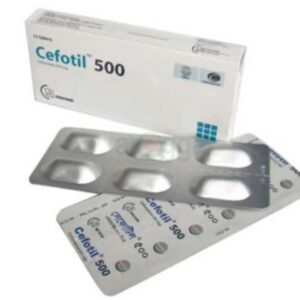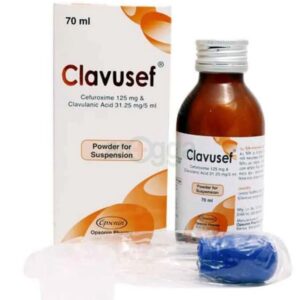Description
Introduction
Avolac 100 is a type of sugar used to treat constipation. It is known as a laxative and makes your stool easier to pass by drawing water into your bowel. It is also used to treat hepatic encephalopathy (a liver disease causing confusion, tremor, decreased level of consciousness). Avolac 100 can be taken with or without food. You should take this medicine as advised by your doctor. Use this medicine regularly to get the maximum benefit and try to take it at the same time(s) each day. Your dose may go up or down depending on how well it is working. Do not take more than you are advised to and, if you miss a dose, do not take an extra one to make up for it. This medicine takes at least 48 hours to work. Talk to your doctor if you are still constipated after 3 days. The most common side effects are nausea and vomiting. These are usually mild and go away after a couple of days. Occasionally people develop serious side effects including severe diarrhea and electrolyte imbalance. Talk to your doctor straight away if you notice any of these. Before taking this medicine, you should tell your doctor if you have diabetes or if you are unable to digest milk sugar (lactose intolerant). If you use this medicine over a long period of time, your doctor may want you to have occasional blood tests to check the mineral levels (e.g. potassium and sodium). Do not take other laxative medicines while taking this medicine and check with your doctor if you are pregnant or breastfeeding.
Uses of Avolac 100
- Constipation
- Hepatic encephalopathy
Side effects of Avolac 100
- Abdominal pain
- Nausea
- Vomiting
- Diarrhea
How to use Avolac 100
Take this medicine in the dose and duration as advised by your doctor. Check the label for directions before use. Measure it with a measuring cup and take it by mouth. Shake well before use. Avolac 100 may be taken with or without food, but it is better to take it at a fixed time.
How Avolac 100 works
Avolac 100 works by drawing water into the intestine through osmosis, which makes the stool soft and easier to pass.
What if you forget to take Avolac 100?
If you miss a dose of Avolac 100, skip it and continue with your normal schedule. Do not double the dose.
 Quick Tips
Quick Tips- Avolac 100 is used in the treatment of constipation and hepatic encephalopathy.
- It should preferably be taken at bedtime as it requires 6 to 8 hours to show effect.
- It is usually taken once a day as needed for up to 2 weeks. Take it exactly as prescribed by the doctor.
- Some healthy tips to prevent constipation from happening:
- Take it atleast 2 hours after taking other medicines, as it may interfere with the absorption of other medicines.
- Inform your doctor if you have a history of stomach disorders such as appendicitis or a blockage in your bowel.
 Brief Description
Brief DescriptionIndication
Constipation, Hepatic encephalopathy
Adult Dose
Constipation Solution: 15-30 mL (10-20 g) PO once daily; may be increased to 60 mL (40 g) once daily Portal Systemic Encephalopathy Prophylaxis 30-45 mL (20-30 g) PO q6-8hr, adjusted until 2-3 soft stools/day; if acute, may be given q1-2hr until 2-3 soft stools/day Treatment 20-30 g (30-45 mL) PO q1hr to induce rapid defecation; reduced to 20-30 g q6-8hr after defecation achieved; titrated to produce 2-3 soft stools/day
Child Dose
Constipation 0.7-2 g/kg/day (1-3 mL/kg/day) PO in divided doses; not to exceed 40 g/day (60 mL/day) Portal Systemic Encephalopathy Prophylaxis Infants: 2.5-10 mL/day (1.7-6.67 g/day) PO in divided doses; titrated to produce 2-3 soft stools/day Children and adolescents: 40-90 mL/day (26.7-60 g/day) PO in divided doses; titrated to produce 2-3 soft stools/day
Contraindication
Lactulose is contraindicated in patients with galactosaemia and intestinal obstruction.
Mode of Action
Lactulose promotes peristalsis by producing an osmotic effect in the colon with resultant distention. In hepatic encephalopathy, it reduces absorption of ammonium ions and toxic nitrogenous compounds, resulting in reduced blood ammonia concentrations.
Precaution
It should be used with caution in patients with lactose intolerance and diabetes. Lactation: Unknown whether drug is distributed into milk; use with caution
Side Effect
Initial dosing may produce flatulence and intestinal cramps, which are usually transient. Excessive dosage can lead to diarrhoea, dehydration, nusea, vomiting, hypokalemia.
Interaction
May prevent release of mesalazine in the colon. Decreased effect with oral neomycin, antacids.









farook
5 star